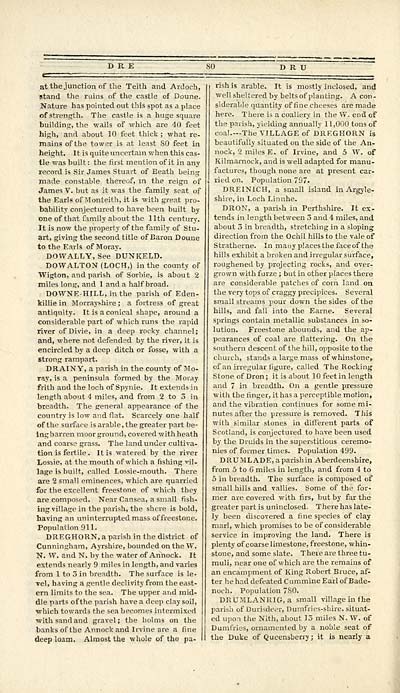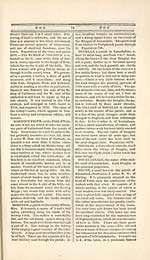Gazetteer of Scotland
(82) Page 80
Download files
Complete book:
Individual page:
Thumbnail gallery: Grid view | List view

DEE
D R U
at the junction of the Teith and Ardoch,
stand the ruins of the castle of Boune.
Nature has pointed out this spot as a place
of strength. The castle is a huge square
building, the walls of which are 40 feet
high, and about 10 feet thick; what re-
mains of the tower is at least 80 feet in
height. It is quite uncertain when this cas-
tle was built : the first mention of it in any
record is Sir James Stuart of Eeath being
made constable thereof, in the reign of
James V. hut as it was the family seat of
the Earls of Monteith, it is with great pro-
bability conjectured to have been built by
one of that family about the 11th century.
It is now the properly of the family of Stu-
art, giving the second title of Baron Doune
to the Earls of Moray.
DOWALLY, See DUNKELD.
DOW ALTON (LOCH,) in the county of
Wigton, and parish of Sorbie, is about 2
miles long, and 1 and a half broad.
DOWNE-HILL, in the parish of Eden-
killie in Morrayshire ; a fortress of great
antiquity. It is a conical shape, around a
considerable part of which runs the rapid
river of Divie, in a deep rocky channel ;
and, where not defended by the river, it is
encircled by a deep ditch or fosse, with a
strong rampart.
DRAINY, a parish in the county of Mo-
ray, is a peninsula formed by the Moray
frith and the loch of Spynie. It extends in
length about 4 miles, and from 2 to 5 in
breadth. The general appearance of the
country is low and flat. Scarcely one half
of the surface is arable, the greater part be-
ing barren moor ground, covered with heath
and coarse grass. The land under cultiva-
tion is fertile . It is watered by the river
Lossie, at the mouth of which a fishing nil-
lage is built, called Lossie-mouth. There
are 2 small eminences, which are quarried
for the excellent freestone of which they
are composed. Near Cansea, a small fish-
ing village in the parish, the shore is bold,
having an uninterrupted mass of freestone.
Population 911.
DREGHORN, a parish in the district of
Cunningham, Ayrshire, hounded on the W.
N. W. and N. by the water of Annock. It
extends nearly 9 miles in length, and varies
from 1 to 3 in breadth. The surface is le-
vel, having a gentle declivity from the east-
ern limits to the sea. The upper and mid-
dle parts of the parish have a deep clay soil,
which towards the sea becomes intermixed
with sand and gravel ; the holms on the
banks of the Annock and Irvine are a fine
deep loam. Almost the whole of the pa-
rish is arable. It is mostly inclosed, and
well sheltered by belts of planting. A con-
siderable quantity of fine cheeses are made
here. There is a coaliery in the W. end of
the parish, yielding annually 11,000 tons of
coal.— The VILLAGE of DREGHORN is
beautifully situated on the side of the An-
nock, 2 miles E. of Irvine, and 5 W. of
Kilmarnock, and is well adapted for manu-
factures, though none are at present car-
ried on. Population 797.
DREINICH, a small island in Argyle-
shire, in Loch Linnhe.
DRON, a parish in Perthshire. It ex-
tends in length between 3 and 4 miles, and
about 3 in breadth, stretching in a sloping
direction from the Ochil hills to the vale of
Stratherne. In many piacesthe faceof the
hills exhibit a broken and irregular surface,
roughened by projecting rocks, and over-
grown with furze ; but in other places there
are considerable patches of com land on
the very tops of craggy precipices. Several
small streams pour down the sides of the
hills, and fall into the Earne. Several
springs contain metallic substances in so-
lution. Freestone abounds, and the ap-
pearances of coal are flattering. On the
southern descent of the hill, opposite to the
church, stands a large mass ofwhinstone,
of an irregular figure, called The Rocking
Stone of Dron ; it is about 1 feet in length
and 7 in breadth. On a gentle pressure
with the finger, it has a perceptible motion,
and the vibration continues for some mi-
nutes after the pressure is removed. This
with similar stones in different parts of
Scotland, is conjectured to have been used
by the Druids in the superstitious ceremo-
nies of former times. Population 499.
DRUMLADE, a parishin Aberdeenshire,
from 5 to 6 miles in length, and from 4 to
5 in breadth. The surface is composed of
small hills and vallies. Some of the for-
mer are covered with firs, but by far the
greater part is uninclosed. There has late-
ly been discovered a fine species of clay
marl, which promises to be of considerable
service in improving the land. There is
plenty of coarselimestone, freestone, whin-
stone, and some slate. There are three tu-
muli, near one of which are the remains of
an encampment of King Robert Bruce, af-
ter he had defeated Cummine Earl of Bade-
noch. Population 7S0.
DKUMLANRIG, a small village in the
parish of Durisdeer, Dumfries-shire, situat-
ed upon the Nith, about 15 miles N. W. of
Dumfries, ornamented by a noble seat of
the Duke of Queensberry ; it is nearly a
D R U
at the junction of the Teith and Ardoch,
stand the ruins of the castle of Boune.
Nature has pointed out this spot as a place
of strength. The castle is a huge square
building, the walls of which are 40 feet
high, and about 10 feet thick; what re-
mains of the tower is at least 80 feet in
height. It is quite uncertain when this cas-
tle was built : the first mention of it in any
record is Sir James Stuart of Eeath being
made constable thereof, in the reign of
James V. hut as it was the family seat of
the Earls of Monteith, it is with great pro-
bability conjectured to have been built by
one of that family about the 11th century.
It is now the properly of the family of Stu-
art, giving the second title of Baron Doune
to the Earls of Moray.
DOWALLY, See DUNKELD.
DOW ALTON (LOCH,) in the county of
Wigton, and parish of Sorbie, is about 2
miles long, and 1 and a half broad.
DOWNE-HILL, in the parish of Eden-
killie in Morrayshire ; a fortress of great
antiquity. It is a conical shape, around a
considerable part of which runs the rapid
river of Divie, in a deep rocky channel ;
and, where not defended by the river, it is
encircled by a deep ditch or fosse, with a
strong rampart.
DRAINY, a parish in the county of Mo-
ray, is a peninsula formed by the Moray
frith and the loch of Spynie. It extends in
length about 4 miles, and from 2 to 5 in
breadth. The general appearance of the
country is low and flat. Scarcely one half
of the surface is arable, the greater part be-
ing barren moor ground, covered with heath
and coarse grass. The land under cultiva-
tion is fertile . It is watered by the river
Lossie, at the mouth of which a fishing nil-
lage is built, called Lossie-mouth. There
are 2 small eminences, which are quarried
for the excellent freestone of which they
are composed. Near Cansea, a small fish-
ing village in the parish, the shore is bold,
having an uninterrupted mass of freestone.
Population 911.
DREGHORN, a parish in the district of
Cunningham, Ayrshire, hounded on the W.
N. W. and N. by the water of Annock. It
extends nearly 9 miles in length, and varies
from 1 to 3 in breadth. The surface is le-
vel, having a gentle declivity from the east-
ern limits to the sea. The upper and mid-
dle parts of the parish have a deep clay soil,
which towards the sea becomes intermixed
with sand and gravel ; the holms on the
banks of the Annock and Irvine are a fine
deep loam. Almost the whole of the pa-
rish is arable. It is mostly inclosed, and
well sheltered by belts of planting. A con-
siderable quantity of fine cheeses are made
here. There is a coaliery in the W. end of
the parish, yielding annually 11,000 tons of
coal.— The VILLAGE of DREGHORN is
beautifully situated on the side of the An-
nock, 2 miles E. of Irvine, and 5 W. of
Kilmarnock, and is well adapted for manu-
factures, though none are at present car-
ried on. Population 797.
DREINICH, a small island in Argyle-
shire, in Loch Linnhe.
DRON, a parish in Perthshire. It ex-
tends in length between 3 and 4 miles, and
about 3 in breadth, stretching in a sloping
direction from the Ochil hills to the vale of
Stratherne. In many piacesthe faceof the
hills exhibit a broken and irregular surface,
roughened by projecting rocks, and over-
grown with furze ; but in other places there
are considerable patches of com land on
the very tops of craggy precipices. Several
small streams pour down the sides of the
hills, and fall into the Earne. Several
springs contain metallic substances in so-
lution. Freestone abounds, and the ap-
pearances of coal are flattering. On the
southern descent of the hill, opposite to the
church, stands a large mass ofwhinstone,
of an irregular figure, called The Rocking
Stone of Dron ; it is about 1 feet in length
and 7 in breadth. On a gentle pressure
with the finger, it has a perceptible motion,
and the vibration continues for some mi-
nutes after the pressure is removed. This
with similar stones in different parts of
Scotland, is conjectured to have been used
by the Druids in the superstitious ceremo-
nies of former times. Population 499.
DRUMLADE, a parishin Aberdeenshire,
from 5 to 6 miles in length, and from 4 to
5 in breadth. The surface is composed of
small hills and vallies. Some of the for-
mer are covered with firs, but by far the
greater part is uninclosed. There has late-
ly been discovered a fine species of clay
marl, which promises to be of considerable
service in improving the land. There is
plenty of coarselimestone, freestone, whin-
stone, and some slate. There are three tu-
muli, near one of which are the remains of
an encampment of King Robert Bruce, af-
ter he had defeated Cummine Earl of Bade-
noch. Population 7S0.
DKUMLANRIG, a small village in the
parish of Durisdeer, Dumfries-shire, situat-
ed upon the Nith, about 15 miles N. W. of
Dumfries, ornamented by a noble seat of
the Duke of Queensberry ; it is nearly a
Set display mode to: Large image | Transcription
Images and transcriptions on this page, including medium image downloads, may be used under the Creative Commons Attribution 4.0 International Licence unless otherwise stated. ![]()
| Gazetteers of Scotland, 1803-1901 > Gazetteer of Scotland > (82) Page 80 |
|---|
| Permanent URL | https://digital.nls.uk/97422678 |
|---|

